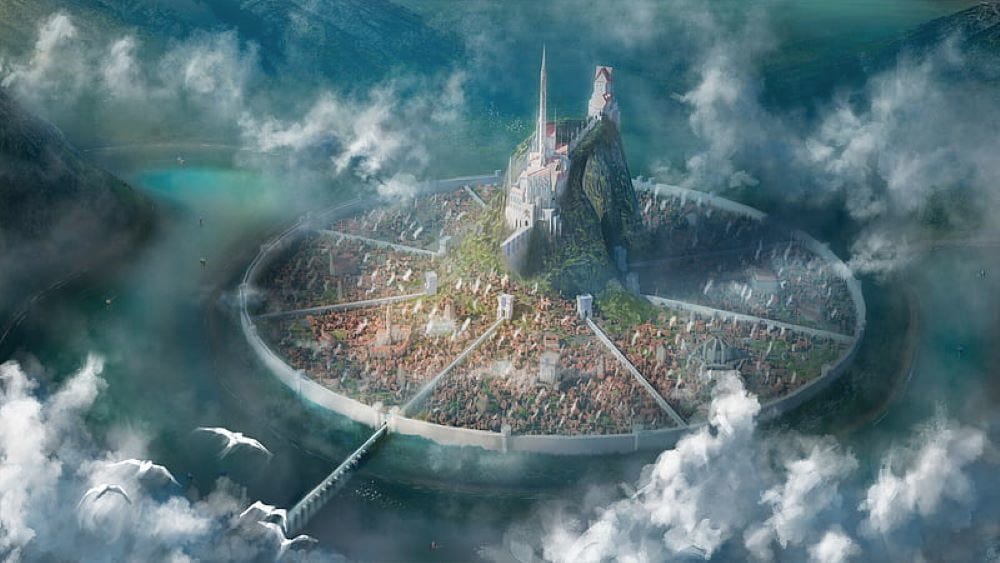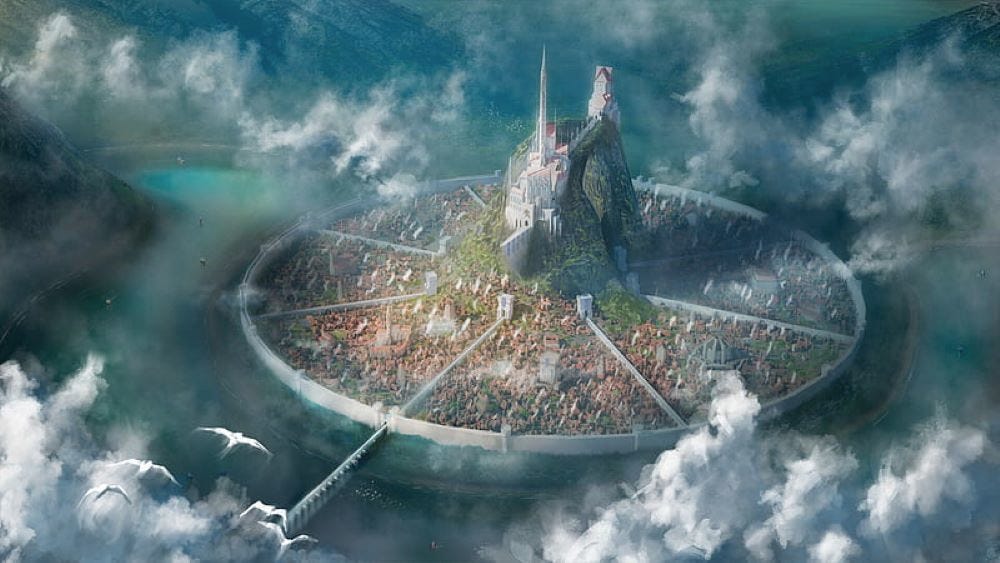The Crisis Report - 15
We are in a moment of history where things could go CATASTROPHICALLY BAD.
The last few weeks have been my brain on overload trying to assimilate everything that’s going on in the world and see the “shape” of events. Things are happening now at a pace that would have seemed unbelievable a few years ago.
I am reminded of Tuchman and her “March of Folly”. I fear we have missed our chance to act cooperatively as a global community and deal with the Climate Crisis collectively. It increasingly seems likely that there will be WAR.
IT’S ABOUT GLOBAL WARMING.
I’m using this image because it makes it easy to visualize my conception of what’s happening. In this image the “ocean” around the island is the Earth’s Oceans. The world’s temperature is set by this ocean. If it cools, the world cools. If it warms, the world warms.
This is a reasonable way to understand the real Earth’s Climate System.
80% of the solar energy the earth captures happens along the equator.
90% of that energy goes into the world’s oceans.
Global Warming is Ocean Warming.
Heat flows from “hot spots” to “cold spots”. It’s how your car’s radiator cools the engine. It “pulls” heat out of the engine and then radiates it away into “space”.
The poles do pretty much the same thing for the earth. The heat energy captured at the equator immediately starts moving towards one of the two poles.
Then, during the months of “no sun”. Heat bleeds out of the Climate System and that hemisphere of the planet has “Winter”.
Here’s the important “bottom line” about the Climate System.
At the end of a yearly cycle the planets energy balance is shown in the Arctic sea ice.
If the ice is expanding and thickening, the planet is cooling.
If the ice is shrinking and thinning, the planet is warming.
That’s what it all comes down to. It’s the bottom line of the Earth’s climate system.

The downward linear trend in December sea ice extent over the 45-year satellite record is 44,400 square kilometers (17,100 square miles) per year, or 3.5 percent per decade relative to the 1981 to 2010 average. Based on the linear trend, since 1978, December has lost 2.28 million square kilometers (880,000 square miles). This is equivalent to about 1.5 times the size of Alaska. Jan 5, 2023 NSIDC
Our Ocean is “heating up”, this affects everything.
Like the ocean in the image, which encircles the island and touches every part of it, every aspect of our planet is “touched” by this warming.
Our Biosphere is changing in response to the warming planet.
The list of things going “wrong” on our planet is endless. Because EVERYTHING in the Earth’s Biosphere is connected to the Earth’s Climate.
Global Warming is “Global”.
Greenland is Melting — FAST
“Dynamic ice loss from the Greenland Ice Sheet driven by sustained glacier retreat” Nature Communications Earth&Environment August 2020
The Arctic is Melting — FAST
The Arctic has warmed nearly four times faster than the globe since 1979 Nature Communications Earth&Environment August 2020
Antarctica is Melting — FAST
As Ice Recedes, Italian Ship Makes Record Journey into the Antarctic
An Italian research mission has sailed further south than any ship has ever done before. The icebreaker Laura Bassi reached a point in the Bay of Whales with the coordinates 78° 44.280 S, the furthest south a ship has ever gone, according to the Italian National Institute of Oceanography and Applied Geophysics.
An attempt to reach the same area in 2017 failed due to too much impenetrable ice.
Sea Levels are Rising — FAST
U.S. coastline to see up to a foot of sea level rise by 2050. Report projects a century of sea level rise in 30 years. NOAA February, 2022
That 12 inches by 2050, that’s a “minimum” estimate. They didn’t incorporate the latest findings from Greenland. Sea level rise could be as high as 2' — 3' feet by 2050.
The world’s Ocean’s are Dying — FAST
In 2017, scientists delivered troubling news in Nature. Overall, the world’s oceans had already lost some 2% of their oxygen since 1960, roughly double what climate models predicted.
Breathless oceans — Warming oceans are running short of oxygen
The 2% drop in oxygen levels seen so far might not sound like much. But global averages can be misleading. There are places in the ocean where there’s been much bigger declines.

In 2018, the scientific arm of the United Nations, UNESCO, issued a report titled The Ocean is Losing its Breath. A year later, the International Union for Conservation of Nature (IUCN) published a 588-page tome detailing the threat to ocean ecosystems and the people who rely on them.
In a 2020 paper, scientists concluded that in this century, declining oxygen would likely have a bigger impact on the ocean than underwater heat waves and ocean acidification.
Wildfires are scorching the planet — EVERYWHERE.
Wildfires increasing worldwide
A 2020 study in Natural Hazards and Earth System Sciences found that the climate change cycle was responsible for one of the largest and deadliest fires in recent history: the Australian wildfires in 2019 and 2020.
Researchers looked at a huge amount of data from the Fire Weather Index, heat and drought patterns, and eleven cutting-edge climate data models, finding that:
Average global 7-day temperature highs in June/July (one of the key wildfire seasons and period of extreme dryness) have risen from about 30°C (86°F) in the 1980s to nearly 35°C (95°F) in 2020
warming global temperatures made extreme heat waves twice as likely to happen
Other areas on this planet that have been experiencing a higher prevalence of wildfires, include Indonesia, Brazil, Argentina, and southern Europe, all places with warm climates. Recently, global regions with colder climes such as western Canada, northern and central Europe, and Siberia have been devastated by wildfires.

Boreal Forest Fires Threaten to Release Deep Soil Carbon
The large majority — roughly 70% — of all fire-related tree cover loss over the past two decades occurred in boreal regions.
Siberia’s massive wildfires are unlocking extreme carbon pollution
Siberian wildfires dwarf all others on Earth combined: Smoke just reached the North Pole in a first.

The Permafrost is Melting — FAST

The melting Permafrost is Releasing — METHANE
Permafrost Thaw in Siberia Creates a Ticking ‘Methane Bomb’ of Greenhouse Gases, Scientists Warn
“In 2020, temperatures in the region rose nearly 11 degrees Fahrenheit above normal, causing the limestone to release ancient methane deposits”
“The estimated amounts of natural gas in the subsurface of North Siberia are huge. When parts of this will be added to the atmosphere upon thawing of the permafrost, this could have dramatic impacts on the already overheated global climate.’
The list of things “going wrong” in the biosphere is endless. Because the Biosphere we live in, is completely connected to the “Climate” we have caused to rapidly get hotter.
Our Anthroposphere is in CRISIS.

End Part One.
-rc 020523








